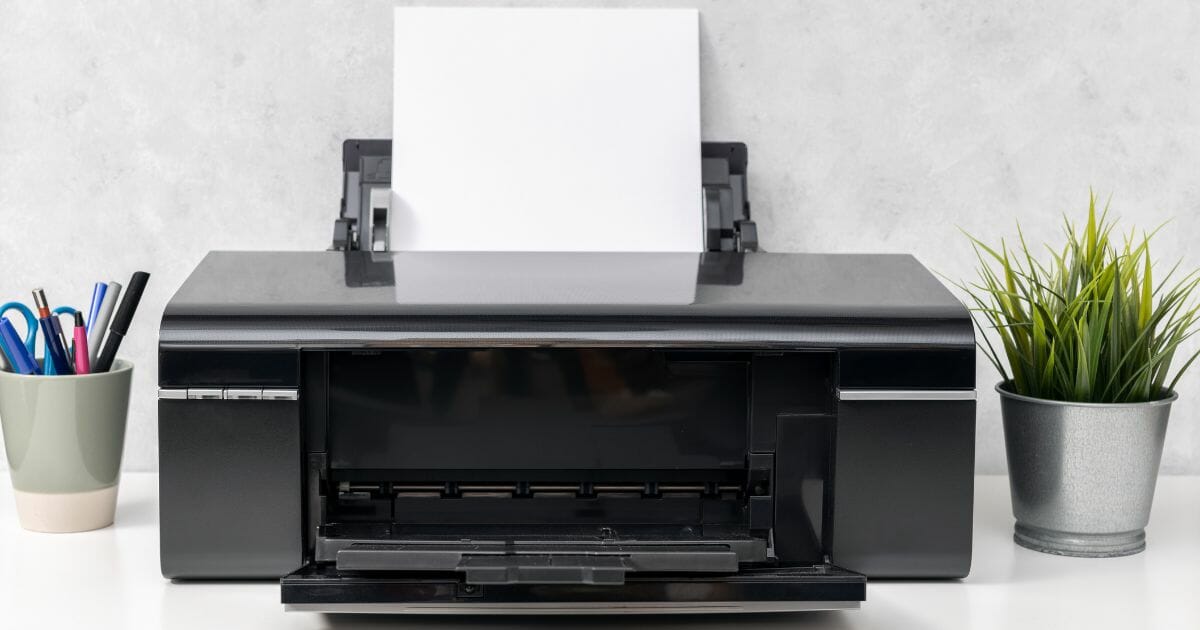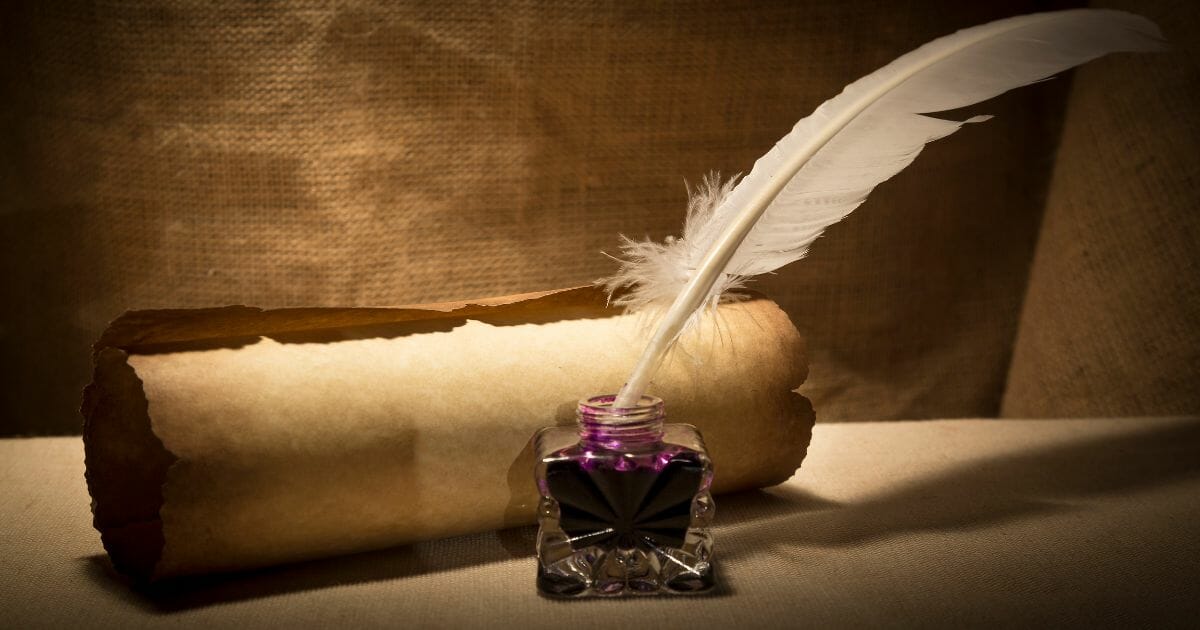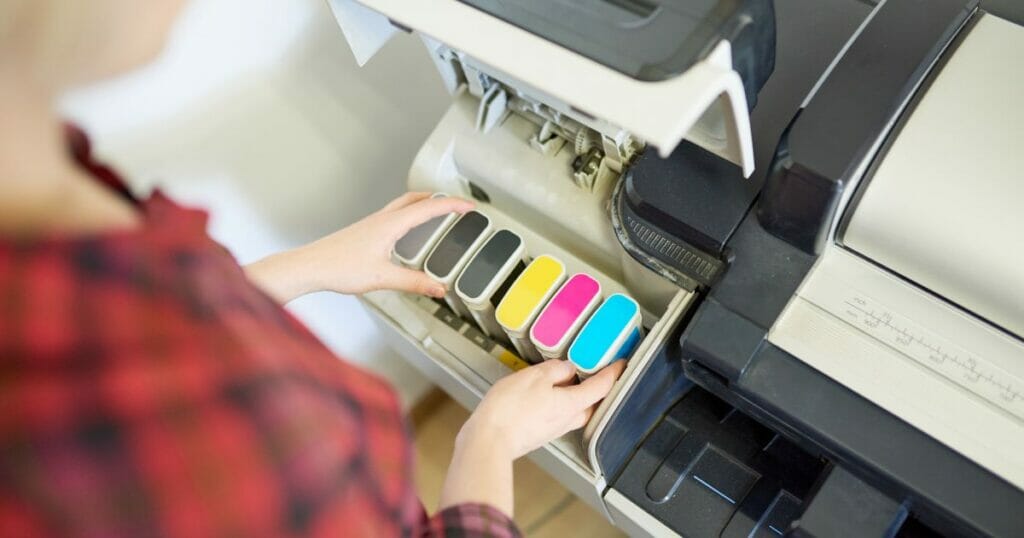SeaRanchLodge.com is a participant in the Amazon Associate program and will earn from qualifying purchases.
Printing might be one of the things we all take for granted today.
It’s just too easy to get freshly printed material at any time – we don’t stop and think about the process behind it all.
What is printer ink made of? Is it the same as writing ink? And why is it so expensive?
Join us in a quest to find out the origins and modern uses of ink!
What Is Ink?

Ink can come in 3 different forms – sol, solution, and gel.
Whereas gel is semi-solid and solution is liquid, sol lies somewhere in between, being made out of tiny solid particles suspended in a liquid.
Be that as it may, those are only the forms in which ink can appear. The most important characteristic is certainly the color.
Every ink has at least one colorant (i.e. a dye) which gives the ink its hue. By combining different colored inks, we can print colorful text and images on any surface.
However, inks are not limited only by the dye. Many different chemicals can and are present in modern ink, and each affects the ink in its own way.
These chemicals are part of the quest of finding out what is printer ink made of.
Therefore, various solvents, resins, lubricants, etc. alter the ink and the way it flows and dries, and impact its viscosity.
Due to all those factors, it might be overwhelming to choose the right ink for our needs when the chemical makeup has such an impact on the final product.
Knowing the ins and outs of ink will help us answer “what is printer ink made of,” and eventually, to confidently choose the ink we need.
What Is Printer Ink Made Of?
Printer ink is made of colorants (pigments), solvents, resins, and varnishes. Additional ink ingredients such as additives (lubricants and driers) affect the viscosity and drying of the ink.
As opposed to writing ink, printer ink’s color comes from pigments and not dyes.
Pigments spread through the compound more evenly and help destroy any lumps that were formed during the mixing process.
The thing printer ink is probably most famous for is its price. As we already mentioned, the revenue in the ink industry is counted in the billions each year.
To illustrate the prices a bit better, for 1 fl oz of ink a consumer will pay between $13 and $95 an ounce. To put that into perspective – one fl oz (fluid ounce) is one-sixteenth of a US pint, or about 0.03 liters.
Due to such high prices, consumers will opt to buy off-brand ink cartridges for their printers, a practice that costs the ink industry billions of dollars.
However, such practices are not recommended by industry experts, and not only because of the financial impact that they will feel.
Off-brand ink cartridges, though compatible with your printer, do not provide the same level of quality as official, branded refills do.
After seeing the process and what is printer ink made of, the sky-high price seems more understandable.
There’s also a risk of your printer malfunctioning due to flaws in the off-brand ink cartridge. Sometimes it’s best to choose quality over quantity.
Just in case there are still those who are confused about what exactly printer ink is and how it relates to toner, we’ll look at the two types of printers that use ink and toner respectively:
- Laser printer
- Inkjet printer
Laser Printer

Laser printers, as their name suggests, use lasers to print text, graphics, and/or images. The process is rather intricate:
- The laser is passed back and forth over a part called “the drum” to define the image, while simultaneously charging it.
- The drum then uses the toner powder (not liquid ink) to trace the image on the printing surface
- The image is then heated and fused to the printing surface
As you could notice, the ink used in laser printing is powdered and is known as toner.
Inkjet Printer

Inkjet printing differs from laser printing not only in the way ink is applied to the printing surface but also in the quality – inkjet printed pictures are of such a high quality that they’re sold under special trade names.
The process itself is rather simple – drops of ink are “shot out” of jets onto the printing surface, that way recreating any and all images.
Such a way of ink application is possible to understand, in part, because we now know what is printer ink made of.
Besides the high-quality product, inkjet printers are basically noiseless compared to other types of printers and only produce faint sounds.
There’s no need to wait for the printer to warm up or cool down in between printing, which makes inkjet printers favorable to those with a bigger workload.
Due to their high speed, inkjet printers have been adapted to printing various materials (like ceramics and biomaterials) and are even used for 3-D printing.
A disadvantage of these printers is the way inkjet cartridges often declare themselves empty, obstructing any printing until they’re changed.
This happens due to microchips imbued in the cartridges that are there to notify the printer and user that the cartridge is empty.
However, the chips tend to send these notifications way before the cartridge is actually empty, causing problems for the consumer.
Furthermore, if cheap cartridges are used and a malfunction happens, the warranty issued by the manufacturer is no longer valid.
Ink and Toner
Just in case there’s still confusion about the two types of ink, we’ll explain it once more.
Toner is, basically, powdered ink and is used in laser printers. Although the text and graphs printed with it are of high quality, the pictures leave a lot to be desired.
Ink, or printer ink, is liquid and is used in inkjet printers (among other things). It allows for a more detailed and high-quality printing of pictures, but is also more expensive.
And considering we saw what printer ink is made of, the price tag kind of seems warranted.
Additionally, it would be remiss of us not to mention one of the tastiest innovations of the printing industry – edible ink.
Edible Ink
Edible ink is used for the printing of edible pictures and decorations, mostly on baked goods and confections.
You’ve probably been on a child’s birthday party where the birthday cake had a picture of Spider-Man, Naruto, or the Minions on it.
Well, those pictures were printed just like any other, but the printing surface and ink sets them apart from normal printing products.
Edible ink, a mix of water, vegetable oil, sugar, and food coloring, is used to bring those characters to life.
To ensure that both the ink and printing surface are completely edible, the pictures are printed on frosting paper (or similarly edible papers).
Edible ink can be used in regular inkjet printers, for example. However, due to possible health concerns, the printer used for edible printing should solely be dedicated to food.
This means no alternating use of printer ink and edible ink, or else possible contamination will occur.
And, of course, a regular cleaning schedule is necessary.
History of Ink

Who was the first person that discovered ink? That’s a bit of a head-scratcher if we’re being honest.
It’s impossible to even safely say which civilization was the first to do it. That’s just how ancient the discovery of writing ink was.
The safest bet is to say that multiple ancient civilizations discovered ink either at the same time, or from the same source: fire.
The first “invention” of mankind, was fire. It propelled humanity’s technological advancement into overdrive and is the first, and possibly biggest, eureka moment in our history.
And it is through a byproduct of fire that ink came about, namely carbon black (also known as lampblack).
It is through this same carbon black, which can be retrieved from the charred wood or bone, that ink came to be.
Take a look at the ancient Egyptians, Chinese, Romans, or whichever civilization you choose, you will find evidence of writing with ink thousands of years ago.
The Chinese in particular mastered the production of ink to such an extent that they had created one of the most famous inks of the ancient world – India ink – which, ironically, is not named after China.
They would procure materials for the ink from India, which is where the name for the ink stems from. The mixture of materials would be ground up and left to dry out in a bowl.
Afterward, a wet brush would be used to liquidize the ink and make it usable for writing.
Ancient ink techniques would prevail in Europe into the middle ages and the advent of the printing press. Due to the nature of the printing process, the norm was not enough – new ink was needed.
Gutenberg’s ink proved to hold up well – it was a mix of lampblack, oil, varnish, and egg whites. Later, other oil based inks were made specifically for the use in printing presses.
Gutenberg’s ink can’t answer the question, “what is printer ink made of?” but it is a great starting point to see just where the development of printing ink started.
Through the birth of the printing press, ink became a hot commodity and a mainstay in the life of the general populace as well as the scholars and royalty that had access to it before.
But to answer the question, “what is printer ink made of?” we need to see all the different applications of ink in the modern world.
Modern Applications of Ink
Just like in times of old, ink is still used for writing! Whether it is with fountain pens or special ink brushes, writing with ink is alive and kicking today.
Before answering the question “what is printer ink made of?” let us go through some modern applications of ink in different areas of life.
A specialized way of ink writing, done for its aesthetic quality, is calligraphy, an artform that gives normal letters a new, artistic life.
Although, if you are looking to buy a calligraphy piece as decoration, don’t expect to be able to read it easily – the intricacies of the writing make the words almost unreadable, but it doesn’t take away from their beauty.
Ink is also used in the food industry both to label items but also to decorate them. The latter part is done via edible ink, which will be mentioned further below.
Another artistic use of ink is in the beauty industry.
Tattoos have also been a big part of our history. Their spiritual meaning was important to ancient cultures, but today they’re mostly done for beauty purposes.
And last but certainly not least – printing!
Whether it is in laser printers or inkjet printers, ink is an irreplaceable part of the printing process.
Demand for printing ink is so high that expectations are that future revenues generated by ink sales will exceed 50 billion dollars! Yes, you read that one right.
So what is printer ink made of exactly that makes it such an expensive but necessary commodity?
Closing Remarks
Printer ink is the continuation of a thousand-year-old formula. The different chemical compounds make it an expensive commodity, but the price dictates the quality – so be prepared to dish out the cash for high-quality ink.
Not only did you find out what is printer ink made of, but we also provided you with a short overview of the history of ink.
Although fewer books and newspapers are being printed today (because of the rise of the internet and smartphones), ink always finds other uses for itself.
With this much inside knowledge about what is printer ink made of, you are now ready to make educated decisions when buying your next ink cartridge.


